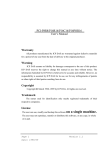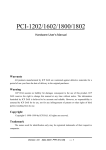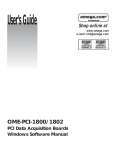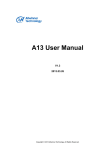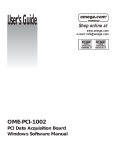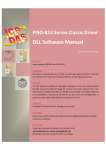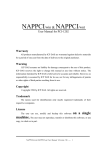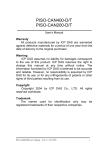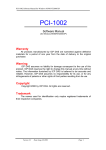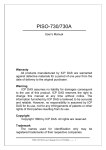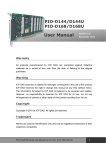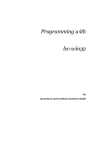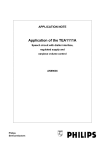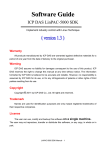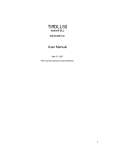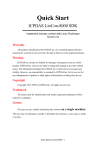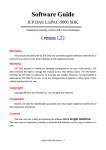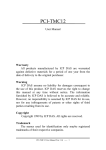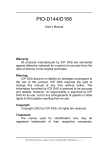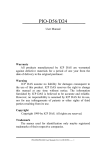Download WDT-01 - ICP DAS
Transcript
WDT-01
Windows Software User Manual
Warranty
All products manufactured by Acquire Inc. are warranted against defective
materials for a period of one year from the date of delivery to the original purchaser.
Warning
Acquire Inc. assume no liability for damages consequent to the use of this product.
Acquire Inc. reserves the right to change this manual at any time without notice. The
information furnished by Acquire Inc. is believed to be accurate and reliable. However,
no responsibility is assumed by Acquire Inc. for its use, nor for any infringements of
patents or other rights of third parties resulting from its use.
Copyright
Copyright 1997 by Acquire Inc. All rights are reserved.
Trademark
The names used for identification only maybe registered trademarks of their
respective companies.
License
The user can use, modify and backup this software
on a single
machine. The user may not reproduce, transfer or distribute this software, or any
copy, in whole or in part.
WDT-01 Windows Software User Manual (Version 1.0) ---- 1
WDT-01 Windows Software User Manual (Version 1.0) ---- 2
Table of Contents
1. INTRODUCTION..............................................................................................................................5
1.1 DISK CONTENTS .............................................................................................................................5
2. WINDOWS 95 APPLICATIONS.....................................................................................................7
2.1 C CALL DLLS ................................................................................................................................7
2.2 MFC CALL DLLS ..........................................................................................................................7
2.3 BC++ CALL DLLS .........................................................................................................................8
2.4 VB CALL DLLS ...........................................................................................................................10
2.5 DELPHI CALL DLLS .....................................................................................................................12
2.6 DEMO PROGRAM..........................................................................................................................14
3. DIO....................................................................................................................................................23
3.1 NAPDIO.VXD INSTALLATION ....................................................................................................23
3.2 DIO.H..........................................................................................................................................24
3.3 DIO_SHORTSUB2, DIO_FLOATSUB2..........................................................................................24
3.4 DIO_GETDLLVERSION ................................................................................................................24
3.5 DIO_OUTPUTBYTE......................................................................................................................25
3.6 DIO_INPUTBYTE .........................................................................................................................25
3.7 DIO_OPENVXD ...........................................................................................................................27
3.8 DIO_CLOSEVXD .........................................................................................................................27
3.9 DIO_GETVXDVERSION ...............................................................................................................28
3.10 DIO_INSTALLIRQ ......................................................................................................................28
3.11 DIO_RESETINTCOUNT ..............................................................................................................30
3.12 DIO_GETINTCOUNT ..................................................................................................................30
3.13 DIO DEMO PROGRAM................................................................................................................32
4. RS-232 DRIVER ..............................................................................................................................36
4.1 UART.H......................................................................................................................................36
4.2 SHORT_SUB_2..........................................................................................................................37
4.3 FLOAT_SUB_2 .........................................................................................................................39
4.4 GET_DLL_VERSION ....................................................................................................................39
4.5 OPEN_COM ...............................................................................................................................41
4.6 CLOSE_COM .............................................................................................................................42
4.7 SEND_CMD(RESERVED) ............................................................................................................43
WDT-01 Windows Software User Manual (Version 1.0) ---- 3
4.8 READ_COM_STATUS(RESERVED)...........................................................................................43
4.9 UART_SEND_STR ....................................................................................................................43
4.10 UART_CLEAR_INPUT_BUFFER ..........................................................................................45
4.11 UART_READ_SEND_STATUS..............................................................................................45
4.12 UART_READ_RECEIVE_STATUS .......................................................................................47
4.13 UART_RECEIVE_1_CHAR ....................................................................................................47
4.14 DEMO PROGRAM ........................................................................................................................49
5. WINDOWS NT APPLICATIONS .................................................................................................52
5.1 C CALL DLLS(REFER TO SEC. 2.1) ..............................................................................................52
5.2 MFC CALL DLLS(REFER TO SEC. 2.2) ........................................................................................52
5.3 BC++ CALL DLLS(REFER TO SEC. 2.3) .......................................................................................52
5.4 VB CALL DLLS(REFER TO SEC. 2.4) ...........................................................................................52
5.5 DELPHI CALL DLLS(REFER TO SEC. 2.5) .....................................................................................52
5.6 DEMO PROGRAM(REFER TO SEC. 2.6) ..........................................................................................52
6. DIO....................................................................................................................................................53
6.1 DIO.H..........................................................................................................................................53
6.2 DIO_OUTPUTBYTE......................................................................................................................54
6.3 DIO_INPUTBYTE .........................................................................................................................54
6.4 NAPWNT_INIT..........................................................................................................................56
6.5 NAPWNT_CLOSE .....................................................................................................................56
7. DEMO FOR P16R16DIO................................................................................................................58
8. RS-232 DRIVER ..............................................................................................................................62
WDT-01 Windows Software User Manual (Version 1.0) ---- 4
I.
Introduction
The DOS software driver of WDT-01 is given in “WDT-01 User Manual”. The
function & control details of WDT-01 are also given in that manual. The user should
refer to that manual for details first.
This software & manual is designed for general purpose DIO&RS232 Windows
applications. Therefore the user should refer to “WDT-01 User Manual” first, then
convert these DOS program into Windows program. This software can be used in
Windows 95 & Windows NT.
The USRT.H, UART.LIB & UART.DLL are designed for RS-232 applications.
The DIO.H, DIO.LIB & DIO.DLL are designed for DIO applications.
A.
Disk Contents
It is recommended to install this software driver to your hard disk and backup the
companion floppy disk. The contents of the companion floppy disk are given as
following:
\W95\VB\*.*
\W95\Delphi\*.*
\W95\Vbdemo\*.*
\W95\DIO\*.*
\W95\RS232\*.*
symbol 224 \f "Wingdings" \s 12 VB demo
symbol 224 \f "Wingdings" \s 12 Delphi demo
symbol 224 \f "Wingdings" \s 12 for all DIO cards
symbol 224 \f "Wingdings" \s 12 for all DIO cards
symbol 224 \f "Wingdings" \s 12 for all RS-232 application
\WNT\SYS\*.*
\WNT\Vbdemo\*.*
\WNT\DIO\*.*
\WNT\RS232\*.*
symbol 224 \f "Wingdings" \s 12 for driver registration
symbol 224 \f "Wingdings" \s 12 for all DIO cards
symbol 224 \f "Wingdings" \s 12 for all DIO cards
symbol 224 \f "Wingdings" \s 12 for all RS-232 application
Refer to chapter 2,3,4 for Win 95 applications
WDT-01 Windows Software User Manual (Version 1.0) ---- 5
Refer to chapter 5,6,7,8 for Win NT applications
WDT-01 Windows Software User Manual (Version 1.0) ---- 6
I.
Windows 95 Applications
A.
C Call DLLs
All the demo program given in \W95 are designed with C language. It is testing OK
under Windows 95 and Visual C++ 4.0 compiler. The key points are given as following:
1. Enter the DOS command prompt under Windows.
2. Make sure the PATH include the Visual C++ compiler
3.
Execute the \MSDEV\BIN\VCVARS32.BAT one time to setup the
environment. The VCVARS32.BAT is provided by Visual C++.
4. The source program must include “****.H”
5. Copy the ****.LIB, import library, to the same directory with source program
6. Copy the ****.DLL, to the same directory with source program
7. Edit the source program (refer to \W95???\???.C)
8. Edit the NMAKE file (refer to \W95\???\???.MAK)
9. Edit the BATCH file (refer to \W95\???\???.BAT)
10.
Execute the batch file (???.BAT)
11.
Execute the execution file (???.exe )
NOTE : The ???.lib is used in linking time and the ???.DLL is used in execution
time.
A.
MFC Call DLLs
The usage of UART.DLL for MFC user is very similar to that for C user. It is testing OK
under Windows 95 and Visual C++ 4.0. The key points are given as following:
1. Use MFC wizard to create source code
2. The source program must include “****.H”
3. Copy the ****.LIB, import library, to the same directory with source program
4. Copy the ****.DLL, to the same directory with source program
5.
Select Build/Settings/Link and key “UART.LIB” in the object/library
modules field
WDT-01 Windows Software User Manual (Version 1.0) ---- 7
A.
BC++ Call DLLs
The DLLs are created by Visual C++ 4.0. The ****.H and ****.lib are also
designed for Visual C/C++. The BC++ can not use this two file. The modification part is
given below:
#include <conio.h>
#include <windows.h>
HINSTANCE hDLLLib;
// Step 1 : declare a functionpointer
float CALLBACK (*FLOAT_SUB_2)(flaot fA, float fB);
main()
{
// Step 2 : load dll
hDllLib=LoadLibrary("****.dll");
if (hDLLLib)
{
// Step 3 : get the function address
FLOAT_SUB_2=(FARPROC)GetProcAddress(hDLLLib,"FLOAT_SUB_2");
if (FLOAT_SUB_2)
{
// Step 4 : call function
printf("1.2-3.4=%f",FLOAT_SUB_2(1.2,3.4));
}
else printf("get FLOAT_SUB_2 function address error");
// Step 5 : free library
FreeLibrary(hDLLib);
}
else printf("load ****.dll error");
getch();
}
This usage can be divided into
5 steps listing above. Using this modification
WDT-01 Windows Software User Manual (Version 1.0) ---- 8
and ****.DLL, the user can use BC++ to call DLLs..
WDT-01 Windows Software User Manual (Version 1.0) ---- 9
A.
VB Call DLLs
\W95\VB\UART.DLL
DLLs
symbol 224 \f "Wingdings" \s 12
\W95\VB\FROM1.FRM
and source file
\W95\VB\MODULE1.BAS
declare file
\W95\VB\PROJECT1.VBP
project file
symbol 224 \f "Wingdings" \s 12
form
symbol 224 \f "Wingdings" \s 12
symbol 224 \f "Wingdings" \s 12
NOTE : 1. Testing under Windows 95 and VB 4.0 (32 bits)
2. The MODULE1.BAS
is designed for demo purpose and the
MODULE1.BAS now only support “SHORT_SUB_2(A,B)”. The user can
modify this file to support all DLLs.
Module1.BAS
Attribute VB_Name = "Module1"
Declare Function SHORT_SUB_2 Lib "a:\w95\vb\uart.dll" (ByVal a As Integer, ByVal b
As Integer) As Integer
FORM1.FRM (partial)
WDT-01 Windows Software User Manual (Version 1.0) ---- 10
Private Sub Command1_Click()
Dim a As Integer, b As Integer, c As Integer
a = Val(Text1.Text)
b = Val(Text2.Text)
c = SHORT_SUB_2(a, b)
Text3.Text = c
WDT-01 Windows Software User Manual (Version 1.0) ---- 11
A.
Delphi Call DLLs
\W95\DELPHI\UART.PAS
symbol 224 \f "Wingdings" \s 12
unit
file
\W95\DELPHI\UART.DLL
DLLs
symbol 224 \f "Wingdings" \s 12
\W95\DELPHI\UNIT1.PAS
source file
\W95\DELPHI\UNIT1.DFM
file
\W95\DELPHI\PROJECT1.DPR
project file
symbol 224 \f "Wingdings" \s 12
demo
symbol 224 \f "Wingdings" \s 12
form
symbol 224 \f "Wingdings" \s 12
NOTE : 1. testing under Windows 95 and Delphi 2.0 (32 bits)
2. The UART.PAS is designed for demo purpose and the UART.PAS now only
support “SHORT_SUB_2(A,B)”. The user can modify this file to support all
DLLs.
unit UART;
interface
function SHORT_SUB_2(a: smallint; b: smallint): smallint; StdCall;
implementation
function SHORT_SUB_2; external 'UART.DLL' name 'SHORT_SUB_2';
end.
procedure TForm1.Button1Click(Sender: TObject) ;
var
a,b,c : smallint;
begin
a := StrToInt(Edit1.text);
WDT-01 Windows Software User Manual (Version 1.0) ---- 12
b := StrToInt(Edit2.text);
c := SHORT_SUB_2(a,b);
Edit3.text := IntToStr(c);
end;
end.
WDT-01 Windows Software User Manual (Version 1.0) ---- 13
A.
Demo Program
We use a common demo program for all ICP DAS C-software demo program. This
demo program will accept the I/O Base Address and DMA Channel Number and IRQ
Channel Number and call the different DLLs for usage demonstration.
Note 1: Some demo program does not use any of these three value
Note 2: Some demo program use these values in different name, format or
functions.
Note 3: The demo program given in this section is used as reference. The user
should refer to ????.C given in floppy disk for details.
#include <windows.h>
#include <stdlib.h>
#include <stdio.h>
#include <conio.h>
#include "****.h"
void READ_CMD(char *);
short
ASCII_TO_HEX(char);
void TEST_CMD(HWND, int, int, int, int);
LRESULT CALLBACK WndProc(HWND, UINT, WPARAM, LPARAM);
short
nDMA=-1, nIRQ=-1;
WORD wBase=0x220;
int iLine;
/* -------------------------------------------------------------------- */
int WINAPI WinMain (HINSTANCE hInstance, HINSTANCE hPrevInstance,
PSTR szCmdLine, int iCmdShow)
{
static char szAppName[] = "TestA822";
HWND
hwnd ;
MSG msg ;
WDT-01 Windows Software User Manual (Version 1.0) ---- 14
WNDCLASSEX wndclass ;
WDT-01 Windows Software User Manual (Version 1.0) ---- 15
wndclass.cbSize = sizeof(wndclass);
wndclass.style
= CS_HREDRAW|CS_VREDRAW;
wndclass.lpfnWndProc = WndProc;
wndclass.cbClsExtra = 0;
wndclass.cbWndExtra = 0;
wndclass.hInstance = hInstance;
wndclass.hIcon
= LoadIcon(NULL, IDI_APPLICATION);
wndclass.hCursor
= LoadCursor(NULL, IDC_ARROW);
wndclass.hbrBackground = (HBRUSH)GetStockObject(WHITE_BRUSH);
wndclass.lpszMenuName = NULL;
wndclass.lpszClassName = szAppName;
wndclass.hIconSm
= LoadIcon(NULL, IDI_APPLICATION);
RegisterClassEx(&wndclass) ;
hwnd=CreateWindow(szAppName,"TESTA822 = [BASE:3] [DMA:1] [IRQ:2]",
WS_OVERLAPPEDWINDOW,
CW_USEDEFAULT, CW_USEDEFAULT,
CW_USEDEFAULT, CW_USEDEFAULT,
NULL, NULL, hInstance, NULL) ;
ShowWindow(hwnd,iCmdShow);
UpdateWindow(hwnd);
while (GetMessage(&msg, NULL, 0, 0))
{
TranslateMessage(&msg);
DispatchMessage(&msg);
}
return msg.wParam;
}
WDT-01 Windows Software User Manual (Version 1.0) ---- 16
LRESULT CALLBACK WndProc(HWND hwnd, UINT iMsg, WPARAM wParam,
LPARAM lParam)
{
static int cxChar, cyChar, cxClient, cyClient, cxBuffer, cyBuffer,
xCaret, yCaret;
static char cBuf[80];
HDC
hdc;
TEXTMETRIC tm;
PAINTSTRUCT ps;
int
i;
switch (iMsg)
{
case WM_CREATE :
// window initial
hdc=GetDC(hwnd);
SelectObject(hdc,GetStockObject(SYSTEM_FIXED_FONT));
GetTextMetrics(hdc, &tm);
cxChar=tm.tmAveCharWidth;
cyChar=tm.tmHeight;
ReleaseDC(hwnd, hdc);
return 0;
case WM_SIZE :
cxClient=LOWORD(lParam);
// window size in pixels
cyClient=HIWORD(lParam);
cxBuffer=max(1,cxClient/cxChar); // window size in characters
cyBuffer=max(1,cyClient/cyChar);
return 0;
case WM_SETFOCUS :
CreateCaret(hwnd, NULL, cxChar, cyChar);
SetCaretPos(xCaret * cxChar, yCaret * cyChar);
ShowCaret(hwnd);
return 0;
case WM_KILLFOCUS :
HideCaret(hwnd);
DestroyCaret();
return 0;
WDT-01 Windows Software User Manual (Version 1.0) ---- 17
case WM_CHAR :
// user press KEYBOARD
for (i = 0 ; i < (int) LOWORD(lParam) ; i++)
{
switch (wParam)
{
case '\b' :
// backspace pressed
if (xCaret > 0)
{
xCaret-- ;
cBuf[xCaret]=' ' ;
HideCaret(hwnd);
hdc=GetDC(hwnd);
SelectObject(hdc,GetStockObject(SYSTEM_FIXED_FONT));
TextOut(hdc, xCaret * cxChar, yCaret * cyChar,cBuf+xCaret,1);
ShowCaret(hwnd);
ReleaseDC(hwnd, hdc);
}
break ;
case '\r' :
// carriage return pressed
cBuf[xCaret]=0 ;
if (xCaret!=0) {xCaret=0; yCaret++;}
READ_CMD(cBuf);
TEST_CMD(hwnd,xCaret, cxChar, yCaret,cyChar);
xCaret=0; yCaret+=iLine;
if (yCaret >= cyBuffer) InvalidateRect(hwnd, NULL, TRUE);
break ;
case '\x1B' :
// escape pressed
InvalidateRect (hwnd, NULL, TRUE) ;
xCaret=yCaret=0;
break ;
WDT-01 Windows Software User Manual (Version 1.0) ---- 18
default :
// other KEY pressed
cBuf[xCaret]=(char) wParam;
HideCaret(hwnd) ;
hdc=GetDC (hwnd);
SelectObject(hdc,GetStockObject(SYSTEM_FIXED_FONT));
TextOut(hdc,xCaret*cxChar,yCaret*cyChar,cBuf+xCaret,1);
ShowCaret(hwnd);
ReleaseDC(hwnd, hdc);
xCaret++;
break ;
}
}
SetCaretPos(xCaret*cxChar, yCaret*cyChar);
return 0;
case WM_PAINT :
// clr and show HELP
InvalidateRect(hwnd, NULL, TRUE) ;
hdc=BeginPaint(hwnd, &ps);
SelectObject(hdc,GetStockObject(SYSTEM_FIXED_FONT));
sprintf(cBuf,"NOW --> Base=%x, DMA=%d, IRQ=%d",wBase,nDMA,nIRQ);
TextOut(hdc,0,0,cBuf,strlen(cBuf));
xCaret = 0 ; yCaret=1;
SetCaretPos(0,yCaret*cyChar);
EndPaint(hwnd, &ps);
return 0;
case WM_DESTROY :
PostQuitMessage(0);
return 0 ;
}
return DefWindowProc(hwnd, iMsg, wParam, lParam);
}
WDT-01 Windows Software User Manual (Version 1.0) ---- 19
/* [0][1][2]=base_address, [4]=DMA, [6][7]=IRQ
void READ_CMD(char szCmd[])
{
short nT1,nT2,nT3;
if (szCmd[0]==0) return;
// only press [Enter]
nT1=ASCII_TO_HEX(szCmd[0]);
nT2=ASCII_TO_HEX(szCmd[1]);
nT3=ASCII_TO_HEX(szCmd[2]);
wBase=nT1*256+nT2*16+nT3 ;
// HEX format
nDMA=ASCII_TO_HEX(szCmd[4]); // DECIMAL format
if (nDMA==0) nDMA=-1 ;
nT1=ASCII_TO_HEX(szCmd[6]);
nT2=ASCII_TO_HEX(szCmd[7]);
nIRQ=nT1*10+nT2;
if (nIRQ==0) nIRQ=-1 ;
}
// DECIMAL format
short ASCII_TO_HEX(char cChar)
{
if (cChar<='9') return(cChar-'0');
else if (cChar<='F') return(cChar-'A'+10);
else return(cChar-'a'+10);
}
/* -------------------------------------------------------------------- */
void TEST_CMD(HWND hwnd, int x, int dx, int y, int dy)
{
WDT-01 Windows Software User Manual (Version 1.0) ---- 20
*/
}
WDT-01 Windows Software User Manual (Version 1.0) ---- 21
The READ_COM only accept
fix format command. The command format
is given as below:
if nDMA=0 symbol 224 \f "Wingdings" \s 12 no DMA is used symbol 224 \f
"Wingdings" \s 12 nDMA will set to -1
if nIRQ=0
symbol 224 \f "Wingdings" \s 12 no IRQ is used symbol 224 \f
"Wingdings" \s 12 nIRQ will set to -1
if =
symbol 224 \f "Wingdings" \s 12 accept current setting of wBase and
nDMA and nIRQ.
WDT-01 Windows Software User Manual (Version 1.0) ---- 22
I.
DIO
This driver is design for
DIO Cards & WDT-01 Card. The
user must refer to the original “???? User Manual” for details. The chapter gives an demo
program for DIO-48. This example is very useful for the other DIO board. It is
recommended to refer to chapter 4 for all DIO user.
A.
NAPDIO.VxD Installation
If the user need to use interrupt, the NAPDIO.VxD must
install in the system before software execution. The installation steps
are given as following:
step 1 : place the companion floppy disk into A
step 2: enter DOS prompt under Windows
step 3 : a:
step 4 : cd w95
step 5 : cd dio
step 6 : cd vxd
step 7 : copy napdio.vxd c:\windows\system\*.*
step 8 : power off the computer then power on
If the user try to
execute the demo program given in the companion floppy disk,
the NAPDIO.VxD must be installed first.
The DIO.DLL will call NAPDIO.VxD automatically.
WDT-01 Windows Software User Manual (Version 1.0) ---- 23
A.
DIO.H
#define EXPORTS extern "C" __declspec (dllexport)
#define NoError
#define VxdOpenError
#define VxdNoOpen
#define GetVxdVersionError
#define InstallIrqError
#define ClearIntCountError
#define GetIntCountError
0
1
2
3
4
5
6
EXPORTS short CALLBACK DIO_ShortSub2(short nA, short nB);
EXPORTS float CALLBACK DIO_FloatSub2(float fA, float fB);
EXPORTS WORD CALLBACK DIO_GetDllVersion(void);
EXPORTS void CALLBACK DIO_OutputByte(WORD wPortAddr, WORD
wOutputVal);
EXPORTS WORD CALLBACK DIO_InputByte(WORD wPortAddr);
EXPORTS WORD CALLBACK DIO_OpenVxd(void);
EXPORTS void CALLBACK DIO_CloseVxd(void);
EXPORTS WORD CALLBACK DIO_GetVxdVersion(WORD *wVxdVersion);
EXPORTS WORD CALLBACK DIO_InstallIrq(WORD wBase, WORD wIrq);
EXPORTS WORD CALLBACK DIO_ResetIntCount(void);
EXPORTS WORD CALLBACK DIO_GetIntCount(WORD *wIntCount);
A.
DIO_ShortSub2, DIO_FloatSub2
test function
A.
DIO_GetDllVersion
test function
WDT-01 Windows Software User Manual (Version 1.0) ---- 24
A.
DIO_OutputByte
Description :
This subroutine will send the 8 bits data to the desired I/O port.
Syntax :
void DIO_OutputByte(WORD wPortAddr, WORD wOutputVal);
Input Parameter :
wPortAddr
wOutputVal
: I/O port address, for example, 0x220
: 8 bits data send to I/O port
Return Value : void
Demo Program : Refer to Sec. 3.13
A.
DIO_InputByte
Description :
This subroutine will input the 8 bits data from the desired I/O port.
Syntax :
WORD DIO_InputByte(WORD wPortAddr);
Input Parameter :
wPortAddr
: I/O port address, for example, 0x220
Return Value :
16 bits data with the leading 8 bits are all 0
WDT-01 Windows Software User Manual (Version 1.0) ---- 25
Demo Program : Refer to Sec. 3.13
WDT-01 Windows Software User Manual (Version 1.0) ---- 26
A.
DIO_OpenVxd
Description : This subroutine will open the NAPDIO.VxD. If the user use
Interrupt, this function must be called once before the
related functions are called.
Syntax : WORD DIO_OpenVxd();
Input Parameter : void
Return Value :
NoError : OK
VxdOpenError : open NAPDIO.VxD error
(copy NAPDIO.VxD into c:\windows\system\*.vxd)
Demo Program : Refer to Sec. 3.13
A.
DIO_CloseVxd
Description :
This subroutine will close the NAPDIO.VxD.
Syntax : void DIO_CloseVxd();
Input Parameter : void
Return Value : void
Demo Program : Refer to Sec. 3.13
WDT-01 Windows Software User Manual (Version 1.0) ---- 27
A.
DIO_GetVxdVersion
Description : This subroutine will read the version number of NAPDIO.VxD.
Syntax : WORD DIO_GetVxdVersion(WORD *wVxdVersion);
Input Parameter : *wVxdVersion : address of wVxdVersion
Return Value :
NoError : OK
VxdNoOpen : the NAPDIO.VxD no open
GetVxdVersionError : read VxD version error
Demo Program : Refer to Sec. 3.13
A.
DIO_InstallIrq
Description : This subroutine will install the IRQ service routine.
Syntax : WORD DIO_InstallIrq(WORD wBase, WORD wIrq);
Input Parameter :
wBase : I/O base address of board
wIrq : IRQ channel number
Return Value :
NoError : OK
VxdNoOpen : the NAPDIO.VxD no open
InstallIrqError : IRQ installation error
Demo Program : Refer to Sec. 3.13
WDT-01 Windows Software User Manual (Version 1.0) ---- 28
WDT-01 Windows Software User Manual (Version 1.0) ---- 29
A.
DIO_ResetIntCount
Description : This subroutine will reset the wIntCount defined in
NAPDIO.VxD.
Syntax : WORD DIO_ResetIntCount();
Input Parameter : void
Return Value :
NoError : OK
VxdNoOpen : the NAPDIO.VxD no open
ClearIntCountError : wIntCount clear error
Demo Program : Refer to Sec. 3.13
A.
DIO_GetIntCount
Description : This subroutine will read the wIntCount defined in
NAPDIO.VxD.
Syntax : WORD DIO_ReadIntCount(WORD *wIntCount);
Input Parameter : *wIntCount : address of wIntCount
Return Value :
NoError : OK
VxdNoOpen : the NAPDIO.VxD no open
GetIntCountError : wIntCount read error
Demo Program : Refer to Sec. 3.13
WDT-01 Windows Software User Manual (Version 1.0) ---- 30
WDT-01 Windows Software User Manual (Version 1.0) ---- 31
A.
DIO Demo Program
void TEST_CMD(HWND hwnd, int x, int dx, int y, int dy)
{
char cBuf[80],cShow[80];
HDC hdc;
WORD wRetVal,wChannel,wConfig,wType,wBuf[10],wCount,i,j;
short nRetVal;
float fRetVal,fVal,fBuf[10];
iLine=0;
hdc=GetDC(hwnd);
HideCaret(hwnd);
SelectObject(hdc,GetStockObject(SYSTEM_FIXED_FONT));
sprintf(cShow,"----------------------------------------------------------");
TextOut(hdc,x*dx,(y+iLine)*dy,cShow,strlen(cShow)); iLine++;
sprintf(cShow,"Now Setting Is --> Base=%x, DMA=%d,
IRQ=%d",wBase,nDMA,nIRQ);
TextOut(hdc,x*dx,(y+iLine)*dy,cShow,strlen(cShow)); iLine++;
wRetVal=DIO_GetDllVersion();
sprintf(cShow,"1. DLL Version=%x",wRetVal);
TextOut(hdc,x*dx,(y+iLine)*dy,cShow,strlen(cShow)); iLine++;
nRetVal=DIO_ShortSub2(1,2);
sprintf(cShow,"2. SHORT_SUB_2(1,2) = %d",nRetVal);
TextOut(hdc,x*dx,(y+iLine)*dy,cShow,strlen(cShow)); iLine++;
fRetVal=DIO_FloatSub2((float)1.0, (float)2.0);
sprintf(cShow,"3. FLOAT_SUB_2(1.0,2.0) = %f",fRetVal);
TextOut(hdc,x*dx,(y+iLine)*dy,cShow,strlen(cShow)); iLine++;
WDT-01 Windows Software User Manual (Version 1.0) ---- 32
wRetVal=DIO_OpenVxd(); // NOTE : this function must call once before
//
the other Vxd-service functions are
//
called. Refer to manual for details.
if (wRetVal==0) sprintf(cShow,"4. [NAPDIO.VXD] Open OK");
else sprintf(cShow,"4. [NAPDIO.VXD] Open Error");
TextOut(hdc,x*dx,(y+iLine)*dy,cShow,strlen(cShow)); iLine++;
wRetVal=DIO_GetVxdVersion(&i);
if (wRetVal==0) sprintf(cShow,"5. Vxd Version=%x",i);
else sprintf(cShow,"5. Get Vxd Version Error");
TextOut(hdc,x*dx,(y+iLine)*dy,cShow,strlen(cShow)); iLine++;
wRetVal=DIO_InstallIrq(wBase, (WORD)(nIRQ));
if (wRetVal==0) sprintf(cShow,"6. Install Irq Ok");
else sprintf(cShow,"6. Install Irq Error");
TextOut(hdc,x*dx,(y+iLine)*dy,cShow,strlen(cShow)); iLine++;
wRetVal=DIO_ResetIntCount();
if (wRetVal==0) sprintf(cShow,"6. ResetIntCount OK");
else sprintf(cShow,"6. ResetIntCount Error");
TextOut(hdc,x*dx,(y+iLine)*dy,cShow,strlen(cShow)); iLine++;
for (j=0; j<10; j++)
{
wRetVal=DIO_GetIntCount(&i);
if (wRetVal==0) sprintf(cShow,"7. IntCount=%x",i);
else sprintf(cShow,"7. GetIntCount Error");
TextOut(hdc,x*dx,(y+iLine)*dy,cShow,strlen(cShow)); iLine++;
Sleep(1000);
}
DIO_CloseVxd(); // NOTE : this function must call once before
//
program exit (if Vxd-service functions
//
are called) Refer to manual for details.
ShowCaret(hwnd);
WDT-01 Windows Software User Manual (Version 1.0) ---- 33
ReleaseDC (hwnd,hdc);
WDT-01 Windows Software User Manual (Version 1.0) ---- 34
WDT-01 Windows Software User Manual (Version 1.0) ---- 35
I.
RS-232 Driver
A.
UART.H
#define EXPORTS extern "C" __declspec (dllexport)
// return code for UART_SEND_STR
#define UART_START_SEND
1
#define UART_PORT_ERR
2
#define UART_HANDLE_ERR
3
#define UART_STR_LENGTH_ERR
4
// return code for UART_CLEAR_INPUT_BUFFER
#define UART_NO_ERR
0
// #define UART_PORT_ERR
2
// #define UART_HANDLE_ERR
3
// return code for UART_READ_SEND_STATUS
#define UART_THREAD_INIT
5
#define UART_THREAD_START
6
#define UART_THREAD_OVER
7
// others
invalidate
// return code for UART_RECEIVE_1_CHAR
#define UART_RECEIVE_ERR
8
// #define UART_NO_ERR
// #define UART_PORT_ERR
0
2
EXPORTS short CALLBACK SHORT_SUB_2(short nA, short nB);
EXPORTS float CALLBACK FLOAT_SUB_2(float fA, float fB);
EXPORTS WORD CALLBACK Get_DLL_Version(void);
WDT-01 Windows Software User Manual (Version 1.0) ---- 36
// for general purpose UART applications
EXPORTS WORD CALLBACK OPEN_COM(char port, DWORD baudrate, char
checksum);
EXPORTS BOOL CALLBACK CLOSE_COM(char port);
// reserved
EXPORTS WORD CALLBACK SEND_CMD(char port, char cmd[], WORD
wTimeout);
EXPORTS WORD CALLBACK READ_COM_STATUS(char port, char Buf[], WORD
*status);
// for general purpose UART applications
EXPORTS WORD CALLBACK UART_SEND_STR(char port, char cmd[]);
EXPORTS WORD CALLBACK UART_CLEAR_INPUT_BUFFER(char port);
EXPORTS WORD CALLBACK UART_READ_SEND_STATUS(char port);
EXPORTS WORD CALLBACK UART_READ_RECEIVE_STATUS(char port);
EXPORTS WORD CALLBACK UART_RECEIVE_1_CHAR(char port, char
*cReadChar);
A.
SHORT_SUB_2
Description :
Compute C=A-B in short format, short=16 bits sign integer. This function is
provided for testing purpose. To test this DLLs can be called by your programming
language, call this subroutine for testing. If this subroutine return the correct value, the
other DLLs will work OK also.
Syntax :
short SHORT_SUB_2(short nA, short nB);
Input Parameter :
nA : short integer
nB : short integer
Return Value :
WDT-01 Windows Software User Manual (Version 1.0) ---- 37
return=nA-nB symbol 224 \f "Wingdings" \s 12 short integer
Demo Program : void
WDT-01 Windows Software User Manual (Version 1.0) ---- 38
A.
FLOAT_SUB_2
Description :
Compute C=A-B in float format, float=32 bits floating pointer number. This
function is provided for testing purpose. To test this DLLs can be called by your
programming language, call this subroutine for testing. If this subroutine return the
correct value, the other DLLs will work OK also.
Syntax :
float FLOAT_SUB_2(float fA, float fB);
Input Parameter :
fA : floating point value
fB : floating point value
Return Value :
return=fA-fB symbol 224 \f "Wingdings" \s 12 floating point value
Demo Program : void
A.
Get_DLL_Version
Description :
Read the software version of the NAP6000 DLLs.
Syntax :
WORD Get_DLL_Version(void) ;
Input Parameter :
void
Return Value :
return=0x102 symbol 224 \f "Wingdings" \s 12 Version 1.2 (WORD=16 bits
WDT-01 Windows Software User Manual (Version 1.0) ---- 39
unsigned integer)
Demo Program : void
WDT-01 Windows Software User Manual (Version 1.0) ---- 40
A.
OPEN_COM
Description :
This function will initialize the COM port. This function must be called before
sending any command string.
Syntax :
WORD OPEN_COM(char cPort, DWORD dwBaudRate, char cChecksum)
Input Parameter :
cPort : 1=COM1, 2=COM2, 3=COM3, 4=COM4, others = invalidate
dwBaudRate : 1200/2400/4800/9600/19200/38400, others=invalidate
cChecksum : reserved
Return Value :
1 = open COM OK
2 = port number error (validate only foe 1/2/3/4)
3 = baud rate value error (validate only for 1200, 2400, 4800, 9600, 19200, 38400,
57600, 115200)
4 = open COM port error
5 = set COM port mask error
6 = set buffer size error
7 = set time out error
8 = set DCB error
Demo Program :
Refer to Sec. 4.14
WDT-01 Windows Software User Manual (Version 1.0) ---- 41
A.
CLOSE_COM
Description :
This function will free all the resources used by OPEN_COM. This function must be
called after program exit. The OPEN_COM will return error message if the program exit
without calling CLOSE_COM function.
Syntax :
BOOL CLOSE_COM(char cPort)
Input Parameter :
cPort : 1=COM1, 2=COM2, 3=COM3, 4=COM4, others = invalidate
Return Value :
1 = close COM OK
0 = port number error (validate only foe 1/2/3/4)
Demo Program :
Refer to Sec. 4.14
WDT-01 Windows Software User Manual (Version 1.0) ---- 42
A. SEND_CMD(reserved)
B. READ_COM_STATUS(reserved)
A.
UART_SEND_STR
Description :
This function will create a thread to send out string. The input string is terminated
with 0 . After create the thread, this function will return to the caller at once. So the
caller and the thread will be executed in multitasking environment. The thread will
auto terminated
when the input string is sent over. The caller can call
“UART_READ_SEND_STATUS” to read the status of this thread.
Syntax :
WORD UART_SEND_STR(char cPort, char szCmd[])
Input Parameter :
cPort : 1=COM1, 2=COM2, 3=COM3, 4=COM4, others = invalidate
szCmd : the starting address of the command string
Return Value :
UART_START_SEND = create a thread to send input string and return at once
UART_PORT_ERR
= port number error (validate for 1/2/3/4 only)
UART_HANDLE_ERR = COM port not initialize or OPEN ERROR
UART_STR_LENGTH_ERR = input string too long
WDT-01 Windows Software User Manual (Version 1.0) ---- 43
Demo Program :
Refer to Sec. 4.14
WDT-01 Windows Software User Manual (Version 1.0) ---- 44
A. UART_CLEAR_INPUT_BUFFER
Description :
This function will clear the UART input buffer.
Syntax :
WORD UART_CLEAR_INPUT_BUFFER(char cPort)
Input Parameter :
cPort : 1=COM1, 2=COM2, 3=COM3, 4=COM4, others = invalidate
Return Value :
UART_NO_ERR = function OK
UART_PORT_ERR
= port number error (validate for 1/2/3/4 only)
UART_HANDLE_ERR = COM port not initialize or OPEN ERROR
Demo Program : void
A. UART_READ_SEND_STATUS
Description :
This function will read the status of the send_thread.
Syntax :
WORD UART_READ_SEND_STATUS(char cPort)
Input Parameter :
cPort : 1=COM1, 2=COM2, 3=COM3, 4=COM4, others = invalidate
Return Value :
UART_THREAD_INIT
UART_THREAD_START
UART_THREAD_OVER
= create send_thread
= send_thread start to execute
= send_thread send input string OVER
WDT-01 Windows Software User Manual (Version 1.0) ---- 45
Demo Program :
Refer to Sec. 4.14
WDT-01 Windows Software User Manual (Version 1.0) ---- 46
A.
UART_READ_RECEIVE_STATUS
Description :
This function will read the status of the UART receive buffer.
Syntax :
WORD UART_READ_RECEIVE_STATUS(char cPort)
Input Parameter :
cPort : 1=COM1, 2=COM2, 3=COM3, 4=COM4, others = invalidate
Return Value :
0
= no char
others
= number of chars are received in receive buffer
Demo Program : Refer to Sec. 4.14
A.
UART_RECEIVE_1_CHAR
Description :
This function will read 1 char from the UART receive buffer.
Syntax :
WORD UART_RECEIVE_1_CHAR(char cPort)
Input Parameter :
cPort : 1=COM1, 2=COM2, 3=COM3, 4=COM4, others = invalidate
Return Value :
UART_NO_ERR
= receive 1 char OK
UART_PORT_ERR
= port number error (validate for 1/2/3/4 only)
UART_RECEIVE_ERR = UART receive error
WDT-01 Windows Software User Manual (Version 1.0) ---- 47
Demo Program :
Refer to Sec. 4.14
WDT-01 Windows Software User Manual (Version 1.0) ---- 48
A.
Demo Program
void Wait_COM(HWND hwnd, int yy )
{
char cBuf[80],cShow[80],ch;
HDC hdc;
WORD ret,i,t;
hdc=GetDC(hwnd);
SelectObject(hdc,GetStockObject(SYSTEM_FIXED_FONT));
ret=OPEN_COM(COM_PORT,9600L,0);
if (ret!=1)
{
strcpy(cShow,"Open Com Error");
goto ret_label;
}
for (;;)
{
ret=UART_READ_RECEIVE_STATUS(COM_PORT);
if (ret!=0)
{
UART_RECEIVE_1_CHAR(COM_PORT, &ch);
}
else break;
}
t=0;
for (;;)
{
ret=UART_READ_RECEIVE_STATUS(COM_PORT); /* finished or timeout */
if (ret!=0)
{
UART_RECEIVE_1_CHAR(COM_PORT, &ch); /* finished or timeout */
WDT-01 Windows Software User Manual (Version 1.0) ---- 49
if (ch==0x0d) break;
t=0;
}
else Sleep(1);
t++;
if (t>100)
{
strcpy(cShow,"Time Out");
goto ret_label;
}
}
t=0; i=0;
for (;;)
{
ret=UART_READ_RECEIVE_STATUS(COM_PORT); /* finished or timeout */
if (ret!=0)
{
UART_RECEIVE_1_CHAR(COM_PORT, &ch); /* finished or timeout */
if (ch==0x0d) break;
t=0;
cBuf[i]=ch; i++;
}
else Sleep(1);
t++;
if (t>100)
{
strcpy(cShow,"Time Out");
goto ret_label;
}
}
cBuf[i]=0;
strcpy(cShow,"Receive string : ");
strcat(cShow,cBuf);
ret_label:
WDT-01 Windows Software User Manual (Version 1.0) ---- 50
TextOut(hdc,1,yy,cShow,strlen(cShow));
ReleaseDC (hwnd,hdc);
CLOSE_COM(COM_PORT);
}
WDT-01 Windows Software User Manual (Version 1.0) ---- 51
I.
Windows NT Applications
The system driver registration steps of Windows NT are given as following:
1.
2.
3.
4.
5.
6.
7.
8.
Enter DOS prompt
A:
cd wnt
cd sys
copy NAPWNT.SYS c:\WINNT\SYSTEM32\DRIVERS\*.*
REGINI NAPWNT.INI
shutdown the NT, power off
power on, the NAPWNT.SYS will be in NT system
A. C Call DLLs(refer to Sec. 2.1)
B. MFC Call DLLs(refer to Sec. 2.2)
C.
D.
E.
F.
BC++ Call DLLs(refer to Sec. 2.3)
VB Call DLLs(refer to Sec. 2.4)
Delphi Call DLLs(refer to Sec. 2.5)
Demo Program(refer to Sec. 2.6)
WDT-01 Windows Software User Manual (Version 1.0) ---- 52
II.
DIO
This driver is design for
DIO Cards & WDT-01 Card. The user
must refer to the original “???? User Manual” for details.
A.
DIO.H
#define EXPORTS
#define NoError 0
#define OpenError 1
#define DaChannelError 1
EXPORTS WORD CALLBACK NAPWNT_INIT(WORD wPort);
EXPORTS void CALLBACK NAPWNT_CLOSE(void);
EXPORTS void CALLBACK DIO_OutputByte(WORD wBase, WORD wHexValue);
EXPORTS WORD CALLBACK DIO_InputByte(WORD wBase);
WDT-01 Windows Software User Manual (Version 1.0) ---- 53
A.
DIO_OutputByte
Description :
This subroutine will send the 8 bits data to the desired I/O port.
Syntax :
void DIO_OutputByte(WORD wPortAddr, WORD wOutputVal);
Input Parameter :
wPortAddr
wOutputVal
: I/O port address, for example, 0x220
: 8 bits data send to I/O port
Return Value : void
Demo Program : Refer to chapter 7
A.
DIO_InputByte
Description :
This subroutine will input the 8 bits data from the desired I/O port.
Syntax :
WORD DIO_InputByte(WORD wPortAddr);
Input Parameter :
wPortAddr
: I/O port address, for example, 0x220
Return Value :
16 bits data with the leading 8 bits are all 0
WDT-01 Windows Software User Manual (Version 1.0) ---- 54
Demo Program : Refer to chapter 7
WDT-01 Windows Software User Manual (Version 1.0) ---- 55
A.
NAPWNT_INIT
Description :
Initialize the NAPWNT DLLs. This function must be called before the other
DLLs.
Syntax :
WORD NAPWNT(WORD wBase) ;
Input Parameter :
wBase : I/O port base address
Return Value :
0x8000 : invalidate handle
0x4000 : open handle error
NoError : OK
Demo Program : Refer to chapter 7
A.
NAPWNT_CLOSE
Description :
Close the NAPWNT DLLs. This function must be called before program stop
Syntax :
WORD NAPWNT_CLOSE(void) ;
Input Parameter :
void
Return Value :
0x1000 : status error
NoError : OK
WDT-01 Windows Software User Manual (Version 1.0) ---- 56
Demo Program : Refer to chapter 7
WDT-01 Windows Software User Manual (Version 1.0) ---- 57
I.
Demo for P16R16DIO
void TEST_CMD(HWND hwnd, int x, int dx, int y, int dy)
{
char cBuf[80],cShow[80];
HDC hdc;
WORD wRetVal,wChannel,wConfig,wType,wBuf[10],wCount,i,j,wData,wVal;
short nRetVal;
float fRetVal,fVal,fBuf[10];
if (wOpen==0)
/* need to init once */
{
NAPWNT_INIT(wBase);
wOpen=1;
}
iLine=0;
hdc=GetDC(hwnd);
HideCaret(hwnd);
SelectObject(hdc,GetStockObject(SYSTEM_FIXED_FONT));
sprintf(cShow,"----------------------------------------------------------");
TextOut(hdc,x*dx,(y+iLine)*dy,cShow,strlen(cShow)); iLine++;
sprintf(cShow,"Now Setting Is --> Base=%x, DMA=%d,
IRQ=%d",wBase,nDMA,nIRQ);
TextOut(hdc,x*dx,(y+iLine)*dy,cShow,strlen(cShow)); iLine++;
DIO_OutputByte(0x7ff4,0x55);
wRetVal=DIO_InputByte(0x7ff4);
sprintf(cShow,"0. 0x55 --> read back=%x",wRetVal);
TextOut(hdc,x*dx,(y+iLine)*dy,cShow,strlen(cShow)); iLine++;
DIO_OutputByte(0x7ff4,0xAA);
wRetVal=DIO_InputByte(0x7ff4);
WDT-01 Windows Software User Manual (Version 1.0) ---- 58
sprintf(cShow,"0. 0xAA --> read back=%x",wRetVal);
TextOut(hdc,x*dx,(y+iLine)*dy,cShow,strlen(cShow)); iLine++;
WDT-01 Windows Software User Manual (Version 1.0) ---- 59
DIO_OutputByte(0x7f7c,0x00);
wRetVal=DIO_InputByte(0x7f7c);
sprintf(cShow,"0. 0x00 --> read back=%x",wRetVal);
TextOut(hdc,x*dx,(y+iLine)*dy,cShow,strlen(cShow)); iLine++;
DIO_OutputByte(0x7f7c,0xff);
wRetVal=DIO_InputByte(0x7f7c);
sprintf(cShow,"0. 0xff --> read back=%x",wRetVal);
TextOut(hdc,x*dx,(y+iLine)*dy,cShow,strlen(cShow)); iLine++;
goto ret_label;
/* this demo is validate for P16R16 */
for (i=0; i<3; i++)
/* relays ON-OFF 5 times */
{
DIO_OutputByte(0x300,0x00); /* R0-R7 OFF */
DIO_OutputByte(0x301,0x00); /* R8-R15 OFF */
Sleep(500);
DIO_OutputByte(0x300,0xff); /* R0-R7 ON */
DIO_OutputByte(0x301,0xff); /* R8-R15 ON */
Sleep(500);
}
DIO_OutputByte(0x300,0x55); /* R0-R7 OFF */
Sleep(500);
wRetVal=DIO_InputByte(0x300);
sprintf(cShow,"1. R0-R7=0x55 --> read back=%x",wRetVal);
TextOut(hdc,x*dx,(y+iLine)*dy,cShow,strlen(cShow)); iLine++;
DIO_OutputByte(0x300,0xAA); /* R0-R7 OFF */
Sleep(500);
wRetVal=DIO_InputByte(0x300);
sprintf(cShow,"2. R0-R7=0xAA --> read back=%x",wRetVal);
TextOut(hdc,x*dx,(y+iLine)*dy,cShow,strlen(cShow)); iLine++;
DIO_OutputByte(0x301,0x55); /* R0-R7 OFF */
Sleep(500);
WDT-01 Windows Software User Manual (Version 1.0) ---- 60
wRetVal=DIO_InputByte(0x301);
sprintf(cShow,"3. R8-R15=0x55 --> read back=%x",wRetVal);
TextOut(hdc,x*dx,(y+iLine)*dy,cShow,strlen(cShow)); iLine++;
DIO_OutputByte(0x301,0xAA); /* R0-R7 OFF */
Sleep(500);
wRetVal=DIO_InputByte(0x301);
sprintf(cShow,"4. R8-R15=0xAA --> read back=%x",wRetVal);
TextOut(hdc,x*dx,(y+iLine)*dy,cShow,strlen(cShow)); iLine++;
ret_label:
ShowCaret(hwnd);
ReleaseDC (hwnd,hdc);
}
WDT-01 Windows Software User Manual (Version 1.0) ---- 61
I.
RS-232 Driver
Refer to Chapter 4 for details. The UART.DLL is a WIN32 driver. It can be run in the
Windows 95 & Windows NT.
WDT-01 Windows Software User Manual (Version 1.0) ---- 62






























































